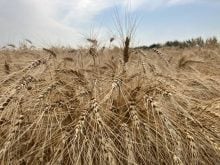CHICAGO, April 15 (Reuters) – The U.S. government will boost support for production of organic crops and produce this year to meet growing consumer demand and boost rural incomes, U.S. Agriculture Department Secretary Tom Vilsack said on Wednesday.
“As demand for organic products continues to soar, more and more producers are entering the organic market,” Vilsack said in a statement.
He said growing demand for organic goods could be especially helpful to smaller family operations. Also, the more diverse the operations and the more growing market sectors there were in American agriculture, the better off the U.S. rural economy would be.
Read Also

U.S. grains: Soybean futures hit one-month high on U.S.-China trade hopes
Chicago Board of Trade soybean futures hit their highest level in a month on Monday on renewed optimism over U.S.-China trade talks after U.S. President Donald Trump said he believed Beijing would agree to a soybean trade deal and will buy U.S. soy again.
According to USDA data, in 2015 there are 19,474 certified organic operations in the United States and 27,814 around the world. The number of U.S. certified operations rose by more than 5 percent in the last 12 months and is up 250 percent since 2002.
Organic agriculture using methods that preserve the environment and avoid most synthetic materials, such as pesticides and antibiotics. USDA organic standards prescribe how farmers grow crops and raise livestock and which materials they may use. The standards cover the food product from farm to table, including soil and water quality, pest control, livestock practices, and food additives.
Demand for organic food, from fruits and vegetables to meat and grains, has risen steadily in the last decade as consumers become more concerned about genetically modified crops and foods as well as chemicals used in the food chain, from fertilizers and herbicide residues to antibiotics in livestock production. Consumers have shown they will pay higher prices for certified organic foods, which has made such operations even more attractive for producers.
In a separate report on Wednesday, the Organic Trade Association released a study reporting that in 2014 a total of $550 million worth of organic products were exported, up $141 million since 2012. Apples, lettuce, grapes, spinach and strawberries were the top exported products, with Canada and Mexico the top destination.
Vilsack said that USDA, using funds from last year’s federal farm bill, will create a new Organic Integrity Database that will provide up-to-date information on certified organic production, sellers and buyers to speed market development.














